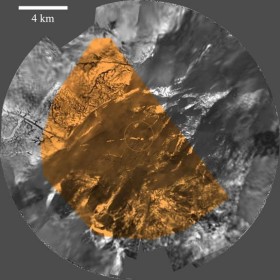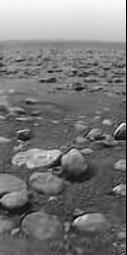|
Press Release 09/2005 - 6th December 2005
"Huygens" discovers harsh environment on Titan
International research team reports surface on Saturn’s moon titan similar to early earth
The conditions on Saturn’s moon Titan with its dense atmosphere resemble those, which prevailed on earth in the early times of the solar system. Researchers of the institute for Max-Planck Institute for solar system research (MPS) were part of an international research team that took images and spectra of Titan’s surface with the space probe "Huygens". Dry riverbeds are seen on the images. The data show that, similar to water on earth, methane exists in solid, liquid and gaseous state on Titan’s surface. On the other hand, the role of water ice on Titan is similar to that of rocks on earth: It is a main constituent of the surface. "Stones", probably mostly consisting of water ice, show traces of erosion and of transport by a liquid (Nature, Advanced on-line Publication, 30 November 2005).

|
Figure 1: Panorama on Titan from a height of eight kilometers. The circle shows the region where "Huygens" probe landed. The colour of the surface as seen by an observer on Titan is indicated. The surface appears orange because the blue and green part of the sunlight is absorbed in the atmosphere of Titan.
(Picture: MPS/ University of Arizona/ESA/NASA)
|
Titan, with a diameter of approximately 5,150 kilometers the largest moon of the Saturn, has a dense and largely opaque atmosphere. Therefore until recently it was one of the few objects in the solar system the surface of which had not been investigated. In 1997 the Cassini/Huygens mission started to the saturn system. The NASA spacecraft  CASSINI was inserted into an orbit around Saturn 2004 and has been investigating the ring planets and its moons since then. The Huygens probe of the European Space Agency ESA was separated from Cassini at the end of 2004. On 14 January 2005 it landed successfully on Titan after a 2.5 hour descent through its atmosphere. CASSINI was inserted into an orbit around Saturn 2004 and has been investigating the ring planets and its moons since then. The Huygens probe of the European Space Agency ESA was separated from Cassini at the end of 2004. On 14 January 2005 it landed successfully on Titan after a 2.5 hour descent through its atmosphere.
Among the scientific instruments on Huygens was the  Descent Imager/Spectral Radiometer (DISR), a combination of altogether 14 cameras, spectrometers for visible and infrared light, and photometers. The Max-Planck-Institute for solar system research contributed the CCD detector to DISR. It collects the signal from all cameras and spectrometers in the visible wavelength range. Descent Imager/Spectral Radiometer (DISR), a combination of altogether 14 cameras, spectrometers for visible and infrared light, and photometers. The Max-Planck-Institute for solar system research contributed the CCD detector to DISR. It collects the signal from all cameras and spectrometers in the visible wavelength range.
DISR investigated the atmosphere and the surface of Titan during descent and after landing of Huygens. On first impression the surface resembles a landscape on earth.: There are rivers which which flow from a higher terrain into into a deeper, flat terrain, separated by would looks like a coastal line (Fig. 1). Spectral investigations also suggest that material was transported from the higher terrain into a "lake".

|
Figure 2: Surface of Titan as seen after landing. The image is taken up from a height of approximately 40 centimeters. The largest "stones" are approximately 15 centimeters in diameter.
(Picture: MPS/University of Arizona/ESA/NASA)
|
Huygens landed in the flat, low-lying region. The images taken after landing (Fig. 2) show that at present there is no liquid in the "lake". However there are "stones", whose rounded shape and size sorting suggest that they may have been entrained in a liquid. At the extremely low temperatures on Titan - about -180 degrees Celsius at the surface - the liquid can be no water. It is rather believed that the liquid consists of methane and/or other hydrocarbons and the "stones" are mostly made of water ice.
The investigations of the atmosphere of Titan concentrated on the haze layer. Before the Huygens mission it was believed that the haze layer is limited to heights of more than 50 kilometers above the surface and the lower atmosphere is clear. The measurements of DISR showed that the haze layer extends down to the surface of the moon. The analysis of the spectra shows that the haze consists of aggregates of several hundred very small particles (about 50 nanometers in size).
Original publication
M. G. Tomasko, B. Archinal, T. Becker, B. Bezard, M. Bushroe, M. Combes, D. Cook, A. Coustenis, C. de Bergh, L. E. Dafoe, L. Doose, S. Doute´, A. Eibl, S. Engel, F. Gliem, B. Grieger, K. Holso, E. Howington-Kraus, E. Karkoschka, H. U. Keller, R. Kirk, R. Kramm, M. Kuppers, P. Lanagan, E. Lellouch, M. Lemmon, J. Lunine, E. McFarlane, J. Moores, G. M. Prout, B. Rizk, M. Rosiek, P. Rueffer, S. E. Schroder, B. Schmitt, C. See, P. Smith, L. Soderblom, N. Thomad & R. West
Rain, winds and haze during the Huygens probe's descent to Titan's surface
Nature, Advanced Online Publication, 30 November 2005
Further informations
Dr. Michael Küppers
Max-Planck-Institut für Sonnensystemforschung
Max-Planck-Str. 2
37191 Katlenburg-Lindau
Tel.: +49 (0)5556 979 - 463
Fax: +49 (0)5556 979 - 240
E-Mail:  kueppers@mps.mpg.de
kueppers@mps.mpg.de
|
